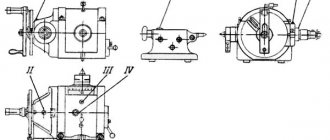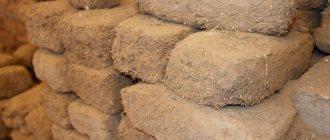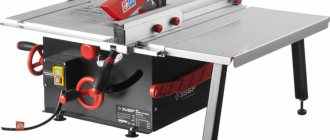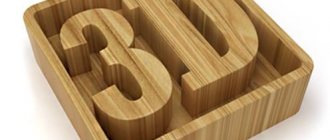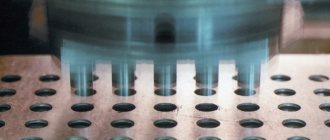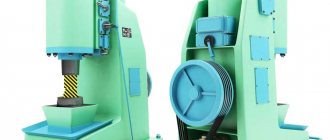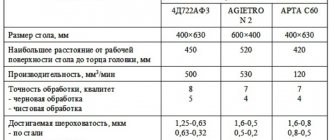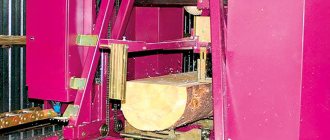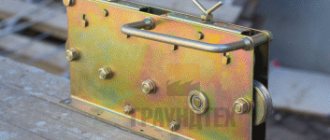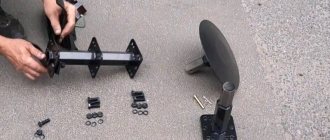Conveyor design features
If the work of the enterprise involves heavy loads, then it is necessary to use equipment that will withstand the large weight of the product.
Therefore, in such cases, chain conveyors are preferred. They are used to move products in inclined and horizontal positions, and to organize reverse directions. They differ from tape ones in that they are bulkier, more complex, and more massive. However, the chain conveyor has great application possibilities, which determines its popularity. Its traction and load-carrying element is one or more chains that move along special guides. The movement occurs thanks to a frame with smooth guides and drive and tension sprockets attached to it. Chain conveyors look like a kind of box, inside of which there is a partition. It may differ in the presence of one or two parallel circuits (depending on the design load and purpose). The rollers have a thrust flange or a cylindrical surface. The transported cargo is moved by the upper or lower branch, depending on the type of device.
There are the following types of chains:
- rollers with smooth rollers;
- roller;
- rollers with flanges on rollers.
It is worth noting that any flail mechanisms for chain conveyors can be produced in dismountable or non-dismountable form. The drive consists of one/two sprockets that are mounted on the drive shaft. Due to the tension of the chain, torque is transmitted from the drive wheel to the driven wheel.
The main design feature of the conveyor is the ability to move large and long loads. If a plate chain is used, then it is possible to transport piece goods of any weight or size.
The chain conveyor can be operated even in high temperature conditions if it does not contain composite or polymer materials. The conveyor can be increased or decreased to the required length thanks to its modular design. The maximum load reaches several tons.
What types of chains are used for chain conveyors:
- box;
- drives made of stainless steel;
- roller;
- bushing-roller;
- lamellar.
By design, depending on the characteristics of the cargo:
- one-two-three-four-row chains;
- with flanges on rollers for chain positioning;
- with rollers for accumulation areas;
- with special pads for fragile products;
- with plates that are needed to secure additional elements.
Noria
A bucket belt elevator, or elevator, is a vertically installed closed belt with buckets along its entire length.
The buckets continuously move in a circular motion up and down: they pick up loose loads at the bottom, lift them to the top and, turning over the head, pour the contents into the receiving hopper. You can read more about this device in our article on grain elevators. Norias are installed on the pellet/mixed feed line when it is necessary to deliver the load vertically to a greater height. In most cases, elevators are used to move finished granules from the cooling column to the filling dispenser container.
Features of elevators from ALB Group
- The modular design of elevators from ALB Group allows them to be easily modified to suit the Customer’s conditions.
- Buckets are made of ST-3 steel, but they can also be made of stainless or galvanized steel.
- A BCNL tape or a food belt with plastic or metal buckets to choose from is installed.
- Optional installation of a tape derailment control device (UKSL).
Construction of chain conveyors
The main components, or sections, included in the design of the device are as follows:
- Driven. This is the frame on which the drive shaft and drive gear are mounted. The drive is also located here - an electric motor and a gear-type reducer that transmits torque to the drive shaft.
- Tension. This is the end of the frame opposite to the leading one. The driven VAZ and gear are fixed in a special spring-loaded bracket. Its distance from the drive shaft is adjusted using a worm drive. The further the driven shaft moves away from the drive shaft, the higher the chain tension.
- Intermediate. It is a frame section between the drive and tension sections. If the conveyor is long enough, passive support shafts with chain-supporting gears can be installed on it. This avoids chain sagging. The number of support shafts is determined during engineering calculations and construction of the conveyor drawing. In scraper type devices there is no need for support shafts.
- Working body. It's the chain itself. Its links can be forged, welded or assembled, like a bicycle chain. On scraper chain conveyors, shields perpendicular to it are attached to the chain, which, moving through the mass of the product, carry it along with them.
For conveyors operating in hot shops, special steel grades are used; electrical equipment, gearboxes and shaft bearings must also be selected in a heat-resistant design.
The load on a chain conveyor can be placed either from above the working branch, on platforms, containers, etc., or from below - on hooks or magnetic hangers.
Introduction.
The goal of the course project is to design a drive for a chain conveyor.
The components of the drive are an asynchronous electric motor, a chain transmission, a coaxial helical gear motor, an elastic safety clutch, and a drive shaft.
The drive device is as follows: torque is transmitted using a mounted gear on the electric motor shaft; from the output shaft of the gearbox through an elastic safety coupling to the drive shaft.
It is necessary to perform the necessary calculations, select the best circuit parameters and develop design documentation intended for the manufacture of the drive:
general view drawing of the gearbox (at the preliminary design stage);
assembly drawing of the gearbox (at the technical design stage);
working drawings of gearbox parts;
general view drawing of an elastic safety coupling;
general view drawing of the drive;
calculation and explanatory note and specifications.
Belt conveyor
Belt conveyors are the most productive type of continuous transport, used for transporting bulk (small lumpy) goods with a bulk density of no more than 1.5 t/m3, containerized or piece goods with varying productivity and conveyor belt speed. The transportation distance can reach up to 300 m, and their route can have a different layout, which allows the conveyors to be adapted to production conditions and terrain.
Technical characteristics and operating principle of belt conveyors
The belt conveyor can be roughly divided into three parts: head, middle and tail. Conveyors can be installed horizontally or inclined up to 18 degrees, depending on the material being transported and the speed of the belt. The conveyor is unloaded at the head or in the middle (for this, plow dumpers or unloading carts are used). Rubber-fabric tape based on TK-100 fabric is used as a load-bearing and traction organ. Based on these indicators, 2-spacer tape on TK-100-2 fabric can successfully replace 4-5 spacer tape on BKNL-65-2 fabric. At the same time, it also has less weight and thickness, which has a positive effect on the service life of the conveyor belt. The conveyor is loaded at the tail end using a special loading device. Lifting, lowering and retracting mechanisms with a transport length of up to 40 m and a belt width of 500 – 650 mm. With a transport length of up to 200 m and a belt width of 500 mm, 650 mm, 800 mm, 1000 mm.
Belt conveyors for containerized or piece cargo are manufactured in three types:
Belt conveyors for containerized or piece cargo are manufactured in three types:
| Conveyor U2-ULK-50/1 | Conveyor U2-ULK-65/1 | Conveyor U2-ULK-80/1 | |||||||||||||
| 00 | 01 | 02 | 03 | 04 | 00 | 01 | 02 | 03 | 04 | 00 | 01 | 02 | 03 | 04 | |
| Productivity: t/h γ=0.75 t/m3 product (grain) | 100 | 175 | 350 | ||||||||||||
| Belt speed, max. m/s | 2,5 | 2,5 | 2,5 | ||||||||||||
| Tape width, mm | 500 | 650 | 800 | ||||||||||||
| Transportation length, m – Lк | 47 | 92 | 137 | 197 | 270 | 47 | 67 | 97 | 142 | 197 | 17 | 37 | 52 | 87 | 117 |
| Installed power, kW | 3* | 5,5* | 7,5* | 11* | 15* | 3* | 5,5* | 7,5* | 11* | 15* | 3* | 5,5* | 7,5* | 11* | 15* |
| Weight 1 l.m. middle part, kg | 20 | 23 | 26 | ||||||||||||
| Trolley track width B1, mm | 770 | 1010 | 1070 | ||||||||||||
| Stand height, N, mm | 735 | 735 | 735 | ||||||||||||
| Trolley type | TR-50m | TR-65m-1sch | TR-80-1sch |
*When working with a TR trolley, the power increases. 50x3 GOST 10704, from rectangular pipe 80x60x3.5 GOST 8645
| Conveyor U2-ULK-50-P1 | Conveyor U2-ULK-65-P1 | Conveyor U2-ULK-80-P1 | |||||||||||||
| 00 | 01 | 02 | 03 | 04 | 00 | 01 | 02 | 03 | 04 | 00 | 01 | 02 | 03 | 04 | |
| Productivity: t/h γ=0.75 t/m3 product (grain) | 100 | 175 | 350 | ||||||||||||
| Belt speed, max. m/s | 2,5 | 2,5 | 2,5 | ||||||||||||
| Tape width, mm | 500 | 650 | 800 | ||||||||||||
| Transportation length, m – Lк | 47 | 92 | 137 | 197 | 270 | 47 | 67 | 97 | 142 | 197 | 17 | 37 | 52 | 87 | 117 |
| Installed power, kW | 3 | 5,5 | 7,5 | 11 | 15 | 3 | 5,5 | 7,5 | 11 | 15 | 3 | 5,5 | 7,5 | 11 | 15 |
| Stand height, N, mm | 735 | 735 | 735 | ||||||||||||
| Route height H1, mm Version 2 | up to 5000 | up to 4000 | up to 3000 | ||||||||||||
| Minimum radius R 1 Version 2, m | 50 – 60 | 75 – 90 | 10 – 150 | ||||||||||||
| Power at version 2, kW | 5,5 | 7,5 | 11 | 15 | 18 | 5,5 | 7,5 | 11 | 15 | 18 | 7,5 | 11 | 15 | 18 | 22 |
| Conveyor U2-ULK-50-P2 | Conveyor U2-ULK-65-P2 | Conveyor U2-ULK-80-P2 | |||||||||||||
| 00 | 01 | 02 | 03 | 04 | 00 | 01 | 02 | 03 | 04 | 00 | 01 | 02 | 03 | 04 | |
| Productivity: t/h γ=0.75 t/m3 product (grain) | 100 | 175 | 350 | ||||||||||||
| Belt speed, max. m/s | 2,5 | 2,5 | 2,5 | ||||||||||||
| Tape width, mm | 500 | 650 | 800 | ||||||||||||
| Transportation length, m – Lк | 47 | 92 | 137 | 197 | 270 | 47 | 67 | 97 | 142 | 197 | 17 | 37 | 52 | 87 | 117 |
| Installed power, kW | 3 | 5,5 | 7,5 | 11 | 15 | 3 | 5,5 | 7,5 | 11 | 15 | 3 | 5,5 | 7,5 | 11 | 15 |
| Stand height, N, mm | 735 | 735 | 735 | ||||||||||||
| Weight 1 lm of the middle part | 140 | 17,5 | 19,0 |
Technical characteristics of the 3SZ VE engine
The technical characteristics of the 3SZ VE engine are described in the table below.
| Parameter | Meaning |
| Volume in liters | 1,5 |
| Fuel | Petrol |
| Drive unit | Morse chain |
| Type | Row |
| Nutrition | MPI injector |
| Power | 110 horses |
| Torque | 145 Nm |
| Cylinder block material | Cast iron |
| cylinder head | Aluminum |
| Cylinder diameter | 72 mm |
| Piston stroke | 91,8 |
| Compression ratio | 10 |
| Turbocharging and hydraulic compensators | None |
| Oil | Not less than 5W30 |
| Ecoclass | Euro 4 |
| Phase regulation | Yes at the inlet (VVTi) |
| Gasoline type | AI 92 |
| Life resource | 250 thousand km |
Seat valves appeared in this engine. The engineers also installed a special cast-iron control unit. Thanks to such innovations, the 3SZ VE engine no longer generates too much heat. As car enthusiasts note, the engine has become easy to operate.
Experienced mechanics say that this engine can be filled with grade 92 fuel. But only cars from Europe with this engine should be filled with grade 95. Because engineers recommend AI 95 for engines that are manufactured specifically for the European market.
Since the modifications of vehicles on which the engine is installed include inexpensive models, the design of the motor model was not complicated. Therefore, many users note how easy it is to repair the engine, even on the knees.
The timing drive is carried out by a Morse chain. This chain can not be found on all Toyota units. Many car owners are unhappy with this design. Because the chain tends to lengthen without expiring its intended lifespan.
Belt conveyor
Belt conveyors are the most productive type of continuous transport, used for transporting bulk (small lumpy) goods with a bulk density of no more than 1.5 t/m3, containerized or piece goods with varying productivity and conveyor belt speed. The transportation distance can reach up to 300 m, and their route can have a different layout, which allows the conveyors to be adapted to production conditions and terrain.
Technical characteristics and operating principle of belt conveyors
The belt conveyor can be roughly divided into three parts: head, middle and tail. Conveyors can be installed horizontally or inclined up to 18 degrees, depending on the material being transported and the speed of the belt. The conveyor is unloaded at the head or in the middle (for this, plow dumpers or unloading carts are used). Rubber-fabric tape based on TK-100 fabric is used as a load-bearing and traction organ. Based on these indicators, 2-spacer tape on TK-100-2 fabric can successfully replace 4-5 spacer tape on BKNL-65-2 fabric. At the same time, it also has less weight and thickness, which has a positive effect on the service life of the conveyor belt. The conveyor is loaded at the tail end using a special loading device. Lifting, lowering and retracting mechanisms with a transport length of up to 40 m and a belt width of 500 – 650 mm. With a transport length of up to 200 m and a belt width of 500 mm, 650 mm, 800 mm, 1000 mm.
Belt conveyors for containerized or piece cargo are manufactured in three types:
Belt conveyors for containerized or piece cargo are manufactured in three types:
| Conveyor U2-ULK-50/1 | Conveyor U2-ULK-65/1 | Conveyor U2-ULK-80/1 | |||||||||||||
| 00 | 01 | 02 | 03 | 04 | 00 | 01 | 02 | 03 | 04 | 00 | 01 | 02 | 03 | 04 | |
| Productivity: t/h γ=0.75 t/m3 product (grain) | 100 | 175 | 350 | ||||||||||||
| Belt speed, max. m/s | 2,5 | 2,5 | 2,5 | ||||||||||||
| Tape width, mm | 500 | 650 | 800 | ||||||||||||
| Transportation length, m – Lк | 47 | 92 | 137 | 197 | 270 | 47 | 67 | 97 | 142 | 197 | 17 | 37 | 52 | 87 | 117 |
| Installed power, kW | 3* | 5,5* | 7,5* | 11* | 15* | 3* | 5,5* | 7,5* | 11* | 15* | 3* | 5,5* | 7,5* | 11* | 15* |
| Weight 1 l.m. middle part, kg | 20 | 23 | 26 | ||||||||||||
| Trolley track width B1, mm | 770 | 1010 | 1070 | ||||||||||||
| Stand height, N, mm | 735 | 735 | 735 | ||||||||||||
| Trolley type | TR-50m | TR-65m-1sch | TR-80-1sch |
*When working with a TR trolley, the power increases. 50x3 GOST 10704, from rectangular pipe 80x60x3.5 GOST 8645
| Conveyor U2-ULK-50-P1 | Conveyor U2-ULK-65-P1 | Conveyor U2-ULK-80-P1 | |||||||||||||
| 00 | 01 | 02 | 03 | 04 | 00 | 01 | 02 | 03 | 04 | 00 | 01 | 02 | 03 | 04 | |
| Productivity: t/h γ=0.75 t/m3 product (grain) | 100 | 175 | 350 | ||||||||||||
| Belt speed, max. m/s | 2,5 | 2,5 | 2,5 | ||||||||||||
| Tape width, mm | 500 | 650 | 800 | ||||||||||||
| Transportation length, m – Lк | 47 | 92 | 137 | 197 | 270 | 47 | 67 | 97 | 142 | 197 | 17 | 37 | 52 | 87 | 117 |
| Installed power, kW | 3 | 5,5 | 7,5 | 11 | 15 | 3 | 5,5 | 7,5 | 11 | 15 | 3 | 5,5 | 7,5 | 11 | 15 |
| Stand height, N, mm | 735 | 735 | 735 | ||||||||||||
| Route height H1, mm Version 2 | up to 5000 | up to 4000 | up to 3000 | ||||||||||||
| Minimum radius R 1 Version 2, m | 50 – 60 | 75 – 90 | 10 – 150 | ||||||||||||
| Power at version 2, kW | 5,5 | 7,5 | 11 | 15 | 18 | 5,5 | 7,5 | 11 | 15 | 18 | 7,5 | 11 | 15 | 18 | 22 |
| Conveyor U2-ULK-50-P2 | Conveyor U2-ULK-65-P2 | Conveyor U2-ULK-80-P2 | |||||||||||||
| 00 | 01 | 02 | 03 | 04 | 00 | 01 | 02 | 03 | 04 | 00 | 01 | 02 | 03 | 04 | |
| Productivity: t/h γ=0.75 t/m3 product (grain) | 100 | 175 | 350 | ||||||||||||
| Belt speed, max. m/s | 2,5 | 2,5 | 2,5 | ||||||||||||
| Tape width, mm | 500 | 650 | 800 | ||||||||||||
| Transportation length, m – Lк | 47 | 92 | 137 | 197 | 270 | 47 | 67 | 97 | 142 | 197 | 17 | 37 | 52 | 87 | 117 |
| Installed power, kW | 3 | 5,5 | 7,5 | 11 | 15 | 3 | 5,5 | 7,5 | 11 | 15 | 3 | 5,5 | 7,5 | 11 | 15 |
| Stand height, N, mm | 735 | 735 | 735 | ||||||||||||
| Weight 1 lm of the middle part | 140 | 17,5 | 19,0 |
Determination of torques on drive shafts.
We determine the required torque on the output shaft of the gearbox:
Torque on the low-speed shaft:
The obtained values are used to calculate gears on a computer
2. Analysis of computer calculation results
When designing, the optimal parameters of the product must be selected that best satisfy various, often conflicting requirements: the smallest weight, dimensions, cost: the highest efficiency; required rigidity and reliability.
The calculation is carried out in two stages. At the first stage, possible design solutions are found and the main quality indicators necessary to select a rational option are determined: the mass of the mechanism, the center distance, the material of the wheel crown, the efficiency factor. Analyzing the calculation results, choose a rational option. To evaluate the calculation results, graphs are drawn that reflect the influence of the distribution:
Option No. 5 was chosen because... has the best indicators in terms of center distance, high-speed gear diameter, weight of wheels and gearbox.
At the second stage, for the selected option, all the design parameters required for working on the drawings are obtained, as well as the meshing forces necessary for calculating the shafts and selecting bearings.
Source
What determines the performance of a chain conveyor?
Considering that the most important element of this equipment are chains for conveyors, they need to be given special attention. They vary in their ability to withstand a certain load and can be:
- single and double row
- equipped with rubber pads
- cumulative
- equipped with additional devices
To ensure that the chain can withstand high loads, the conveyor is additionally equipped with a rigid steel frame.
In general, any chain conveyor is characterized by the highest performance and is reliable in any operating conditions. We will help you select equipment that will fit into any packaging line, including the one already existing at the enterprise, and in any situation this equipment will be very unpretentious in use and maintenance. Conveyors and chains for conveyors at NPF "Master Service" are offered at the best cost, and their production and delivery are carried out in the shortest possible time, which will allow you to quickly complete the production line and start working with any product.
Areas of use
Like many other types of conveying equipment, chain conveyors have found their application in many areas of production. Most often, such analogues can be found in metallurgical production, automobile, aircraft and mechanical engineering, construction and mining enterprises and factories.
Chain conveyors are also used in forging and pressing shops to supply spare parts and parts for hardening or tempering.
In slag processing processes, such equipment is widely popular due to its sealed housing, which reduces the level of dust in production and prevents spillage of materials.
Varieties
Based on the type of housing, experts divide screw conveyors into two main types:
- open;
- closed.
Based on the type of screw used (the number of independent spirals), a distinction is made between single-pass and double-pass. In the direction of rotation of the screw - left and right.
Based on the orientation of the housing, devices are divided into:
- vertical screw conveyor;
- inclined;
- horizontal conveyor.
Inclined and vertical screw conveyors are usually constructed in a closed enclosure to prevent the load being moved from falling.
Screw spiral conveyors are also distinguished according to such parameters as:
- performance;
- blade diameter and pitch;
- conveyor length;
- rpm, etc.
Closed conveyor
Such mechanisms consist of a closed tube within which a screw rotates. The blades are made solid or shaped. This is determined by the required productivity and the type of material being moved. There is a hole at the inlet end of the pipe; it has a receiving tray through which the load is poured into the mechanism. At the opposite end it has an outlet; it is equipped with a pipe that directs the flow in the desired direction. The pipe is equipped with a damper that prevents random objects and precipitation from entering the mechanism.
This design can easily be sealed, so it is ideal for transporting fine bulk substances with increased dust formation. They are suitable for work both in closed production or warehouse premises, and in open space. A vertical auger also requires a closed circuit. They are characterized by high productivity and low losses of transported cargo.
The downside is the complexity of maintenance and repair; access to the auger parts requires complete disassembly of the device.
Open screw conveyor
An open screw conveyor has a simpler design. It is a gutter or a piece of pipe with the top cut out. An auger rotates in the middle of the chute, moving material through it. This design is used mainly in rooms where the cargo is protected from atmospheric phenomena and the ingress of foreign objects.
The advantage is easy access to device parts for maintenance and repair. The disadvantage will be that the conveyor is located exclusively horizontally (or with a minimal slope), otherwise there is a danger of cargo spilling.
Development of the surface of an oblique helical helicoid
A similar screw can also be used if necessary. Let's call its key points the following:
- The surface formed during development is parallel to the corresponding line obtained by rotation of the coaxial cone.
- There is a certain angle at the apex, which is often called the guide cone.
Such a sweep is also taken into account when carrying out a wide variety of calculations.
Graphic method
The method of displaying the mechanism under consideration involves dividing the horizontal projection into equal parts, after which each is taken as an isosceles trapezoid.
In such a case, a fairly large number of different values are taken into account. An example is the width, as well as the angle of the ratio.
Analytical method
The easiest to use is the analytical method. It is based on the principle of dividing the surface of an oblique helicoid into single-sheet hyperboloids of revolution.
In technical documentation you can find formulas that are used to determine the size of the development of one turn.
Motor selection
Р=100mm – conveyor chain pitch;
z=8 – number of sprocket teeth.
To determine power we use the formula:
To determine the required motor power, it is necessary to divide the drive power by the efficiency of the entire drive:
We accept a 3 kW motor.
According to the table of characteristics of electric motors, we select an AIR112MV8 motor with an armature rotation speed n.e.=709 min -1
drive n is calculated using the formula:
, where d=P/sin(180/z)=254.78 mm, then
Belt conveyor device
What is a belt conveyor? It is a belt stretched between two drums, tension and drive. Between the drums, the belt slides along support rollers or a deck. Flooring is used in cases where the mass of the transported cargo is not significant and the length of the route is not very long. The tension drum is a pipe with two flanges through which a shaft and bearing units with a tension device pass. With the help of this drum, the tape is tensioned to the required degree, and is also centered to prevent the tape from slipping. The drive drum is a pipe with two flanges and a shaft at the end of which an electric motor with a gear mechanism is installed.
Which cars were equipped with the 3SZ VE power unit?
Now let's look at which cars this power unit called 3SZVE was installed on. The motor can be seen on:
- Daihatsu Terios;
- Daihatsu Taruna;
- Toyota bB;
- Toyota Avanza;
- Toyota Passo Sette;
- Toyota Rush.
Terios are sold in South America. At its core, the car is considered almost a copy of the Toyota Rush vehicle. Therefore, it is equipped with the same engine from this company 3SZ VE.
Fuel consumption on cars with this engine starts from 5.1 liters per 100 kilometers when driving on the highway. If the car is constantly driving around the city with traffic jams and stops at traffic lights, then the fuel consumption increases by seven and a half liters. In mixed mode, the engine consumes 6.2 liters.
Power units from the following companies are similar to this motor:
- Daewoo G15MF;
- Nissan QG15DE;
- Ford UEJB;
- Honda L15A.
Despite the fact that this engine is widely used among small cars, many users speak negatively about the 3SZ VE engine. However, there are many positive reviews.
Advantages and disadvantages of chain conveyors
During long-term use in various sectors of the economy, the following advantages of chain conveyors have emerged:
- strength to transmit high torque and ensure high performance;
- availability of various sizes and capacities of equipment;
- the possibility of safe transportation of dusty and hazardous goods;
- high resistance to physical and temperature stress.
This type of conveyor also has a number of disadvantages:
- large weight and size;
- high noise and vibration levels;
- the need for regular maintenance to repair or replace worn chain drive parts.
Overall, the advantages compensate for the disadvantages, making chain conveyors a cost-effective and smart choice for organizing the movement of goods in a wide variety of industries.
Kinds
Currently, several types of screw conveyors are produced, differing in functional features and performance properties. In addition, when classifying drills, the following parameters are taken into account:
- gutter slope,
- spiral direction,
- screw design,
- step variability,
- screw diameter,
- compression ratio,
- type of cargo transported.
Depending on which direction the chute is inclined, the auger can be horizontal, vertical, gently inclined or steeply inclined. According to the design of the propeller, it can be solid, bladed, strip or shaped, and according to the number of power zones - 1, 2 and 3-zone.
When choosing a screw conveyor, most people focus on only one parameter – purpose. According to this parameter, the auger can be:
- dosing,
- mixing,
- barrier
Machines with a dosing screw mechanism are used in the polymer processing process. Their main advantage is their improved design and high performance.
Mixing-type mechanisms are indispensable for thorough mixing of materials, polyethylene production and PVC processing. They differ from the previous type of screws by the presence of a mixing section and high rotation speed.
Barrier screw machines are used for enhanced compression and melting of materials. Their design includes a mixing section, which increases productivity.
Application
Chain conveyors are widely used in all industries:
- production of building materials;
- assembly of automotive equipment and components;
- dairy and oil and fat industry;
- production of chemical components, medicines, household chemicals;
- chain conveyors are required for the production and processing of food, beverages, and nutritional supplements;
- pulp and paper industry;
- processing of agricultural products;
- wood processing industry;
- meat, fish and poultry processing industry;
- furniture manufacture;
- assembly of instruments, computer and household appliances.
The conveyor allows you to move piece and packaged cargo, such as:
- products on pallets;
- cargo on pallets;
- containers;
- piles of cardboard, corrugated sheets, plywood;
- lumber;
- high temperature products;
- barrels, etc.
This is interesting: Conveyor - history of appearance, characteristics, device
Operating conditions for scraper conveyors
Before starting, be sure to check the unit, then let it idle. Only after you have ensured that all components are in good working order can you start loading the product, and the quantity is calculated in such a way as to guarantee optimal performance. During operation, you need to monitor the condition of the chains, bearings, tension of the branches, and measure the amount of lubricant in the transmission unit. Scrapers must be checked throughout the entire life of the machine. If any parts are deformed or broken, replace them in time. If the scraper conveyor begins to make a lot of noise during activity, find out the cause and eliminate it during the next pause in operation.
If the noise increases sharply, the unit should be stopped immediately. Observe safety regulations, in particular, great attention should be paid to it when working with open gutters. Place an emergency stop button next to the production line; if the length is long, then there should be several of them; Do not forget about grounding the drive frame and machine and sealing the housing.
It is strictly prohibited:
- Start the scraper conveyor with the guards removed;
- Work with open gearboxes;
- Carry out cleaning, eliminate minor problems during the operation of equipment;
- Carry out repair or adjustment work with the mains voltage turned on.
Types
The most common types of conveyors are:
Screw (auger) conveyor
consists of a groove and an Archimedean screw located in it; used for bulk solids.
- Rope conveyor
- Oscillating Conveyor
used for small objects rolling or sliding on an inclined swaying surface.
Bucket Conveyor
the load-carrying part of the conveyor is buckets, the suspension axis of which passes through the middle point, which allows them to swing; for transporting bulk materials (coal, crushed stone, slag, clinker), buckets are installed with an overlap without gaps, in contrast to mechanisms for gravity loading, like elevators.
Belt Conveyor
consists of an annular belt, tension and drive drums and support rollers; It is usually used for transporting bulk substances; modifications are possible (tubular, z-shaped, rotatable by 90 and 180 degrees) due to the deformation of the belt.
Conveyor with modular belt
consists of a plastic (polyurethane, polypropylene, polyacetal) tape, tension and drive unit with sprockets; used for transporting bulk substances, piece goods, and open products. Conveyors with a modular belt can have a different movement path: rotary, zigzag, spiral.
Plate Conveyor
the load-carrying part of the conveyor is the plates;
chain plate conveyor
- consists of two parallel circuits connected to each other by plates.
- special plastic or stainless steel chains
Pneumatic conveyor
conveyor, the traction of which is provided by air flow
- consists of a tube and closed containers moved along it, tightly adjacent to the walls;
- Bulk material moves in the air flow as a suspension (air chute).
Overhead conveyor
differ in that the moving bodies do not lie, but hang on load-carrying fasteners, and the conveyor mechanisms themselves are also suspended.
Roller conveyor (roller conveyor)
consists of rollers fixed to a frame, individual rollers can be driven, or the entire frame is inclined, as is the case with a gravity roller conveyor; used for large solid objects.
Scraper Conveyor
consists of a chute and scrapers moving bulk material along it, usually attached to a ring chain; unloading can be carried out either at the end of the conveyor or through openings in the chute.
Spiral conveyor (flexible)
consists of a groove and a spiral located in it; used for bulk solids, higher productivity compared to a screw conveyor. consists of a chute and a (wire, ring) rope on which metal discs are attached that move a non-abrasive material (for example, coal) inside the chute.
Trolley conveyor
used for moving assembled and welded units in production lines. When using a floor-mounted trolley conveyor, it is advisable to use trolley platforms for mounting assembly and welding equipment on them.
Walking Conveyor (Stepping Conveyor)
used for moving assembled and welded units in production lines. When using a floor-mounted trolley conveyor, it is advisable to use trolley platforms for mounting assembly and welding equipment on them.
